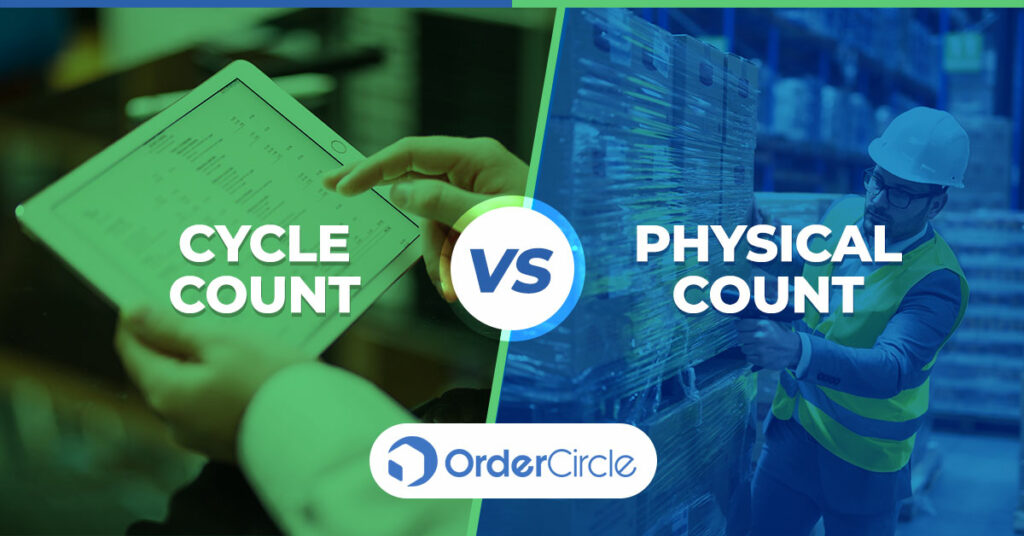Inventory precision remains a fundamental aspect of efficient warehouse management. Within the inventory control arsenal, two primary methods—cycle count and physical count—play pivotal roles in ensuring accurate stock levels. Delving deeper into these methods unveils their distinctive approaches and the critical factors to consider when choosing between them.
Understanding Cycle Count and Physical Count:
-
Cycle Count: A Targeted Approach
Cycle counting adopts a tactical and ongoing strategy where specific portions of inventory are regularly audited within set intervals. Instead of the all-encompassing nature of physical counts, cycle counting focuses on smaller, strategic subsets of inventory. High-value items or products with higher turnover rates often take precedence in these smaller-scale counts.
This method offers advantages in mitigating disruptions to daily operations. By spreading out inventory checks over time, businesses maintain a consistent yet less intrusive approach to validating inventory accuracy.
-
Physical Count: A Comprehensive Review
In contrast, physical counting involves the comprehensive verification of the entire inventory stock at specified intervals. It’s akin to taking a snapshot of the entire inventory landscape, allowing for a thorough evaluation and reconciliation of stock on hand with recorded data.
While this method offers a holistic view of inventory accuracy, it does require more resources and often leads to more significant operational disruptions due to the need to halt operations during the counting process.
Key Differences Between Cycle Count and Physical Count
-
Frequency and Scope:
Cycle counts occur more frequently, addressing smaller inventory portions, while physical counts cover the entire inventory but at less frequent intervals.
-
Accuracy vs. Operational Disruption:
Cycle counts aim for precision without extensively disrupting daily operations, whereas physical counts ensure comprehensive accuracy but can significantly disrupt workflows.
-
Resource Allocation and Timing:
Cycle counts demand consistent allocation of resources over time, whereas physical counts require more resources but at less frequent intervals.
-
Issue Identification and Resolution:
Frequent cycle counts allow for the timely identification and resolution of discrepancies, whereas less frequent physical counts offer a detailed but less timely overview.
Choosing the Right Approach for Your Business:
Selecting the appropriate method—cycle count or physical count—depends on various factors intrinsic to your business operations:
- Inventory Size and Complexity: Smaller businesses with less complex inventories often find cycle counting more manageable and practical. Larger enterprises dealing with extensive inventory might opt for periodic physical counts to ensure comprehensive accuracy.
- Operational Interruptions: Consider the impact of counting methods on daily operations. Cycle counting minimizes disruptions by distributing checks over time, while physical counts result in more significant operational pauses.
- Resource Availability: Evaluate the resources required for both methods. Cycle counts demand consistent resource allocation, while physical counts need more resources but at longer intervals.
- Technology Integration: Advanced inventory management software can streamline both cycle and physical counting processes, enhancing accuracy and reducing the manual workload.
Optimizing Inventory Counts with Technology
Leveraging cutting-edge inventory management systems enhances the effectiveness of both cycle and physical counts. These systems offer real-time tracking, enabling businesses to monitor inventory movements and discrepancies continuously. Furthermore, they can automate data collection, making inventory counts more efficient and accurate.
Conclusion
Cycle count and physical count present divergent approaches to achieving accurate inventory management, each with its advantages and considerations. Choosing between the two methods requires a thorough understanding of your business’s operational dynamics, inventory size, and resource allocation.
A well-thought-out approach might involve incorporating a hybrid strategy, combining the strengths of cycle and physical counts. This hybrid model could offer the precision of physical counts for critical items while leveraging the ongoing nature of cycle counts for other inventory sections.
Ultimately, the goal remains consistent: to achieve optimal inventory accuracy without compromising operational efficiency. An informed decision tailored to the specific needs and scale of your business will be crucial in achieving this balance.
By grasping the essence of both methods, businesses can make informed decisions, align their inventory management strategies accordingly, and ensure sustained success in managing their inventory operations.

